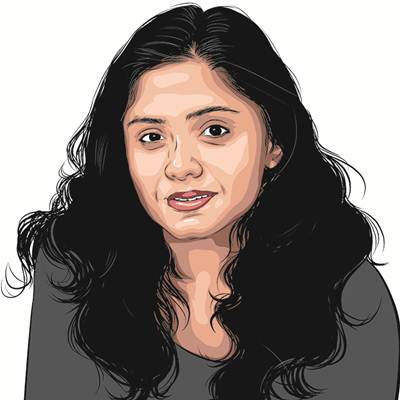Opinion Why Olena Zelenska’s Vogue photoshoot makes us uncomfortable
Benita Fernando writes: The problem isn’t that it makes light of suffering. It’s that it tries to be about war when it actually is about fashion or vice-versa
 Titled ‘Portrait of Bravery’, the photoshoot shows the couple against the backdrop of war-torn Ukraine. (Instagram/Olena Zelenska)
Titled ‘Portrait of Bravery’, the photoshoot shows the couple against the backdrop of war-torn Ukraine. (Instagram/Olena Zelenska) In Regarding the Pain of Others (2003), the late Susan Sontag wrote, “War was and still is the most irresistible — and picturesque — news”. That war is picturesque is a thought that many of us find hard to digest. It suggests that we find beauty and therefore pleasure in images of suffering. It’s also what disturbs us about the latest Vogue digital cover, featuring Ukraine’s first lady, Olena Zelenska and her husband, president Volodymyr Zelenskyy.
Titled ‘Portrait of Bravery’, the photoshoot shows the couple against the backdrop of war-torn Ukraine. Shot by Annie Leibovitz in July 2022 — well over four months since Russia’s invasion of Ukraine began — it has been criticised as a mockery of suffering and war. The story lists Zelenska’s “ecru silk blouse with a black velvet bow” or “chunky white sneakers with yellow and blue detailing, a nod to the Ukrainian flag” or “her hair loose on her shoulders”. Could “Ukraine war chic” be the next big thing on runways this season? The tone is discordant with all that’s happened to Ukrainians since the war began.
View this post on Instagram
In photographs of the couple, Zelenskyy protectively wraps his arm around Zelenska or holds her hand — indicating that his patriotism is nothing less than the love he has for his wife. These have fared better than a solo of Zelenska dressed in a blue coat (much like the robe of the icon of Virgin Mary in St. Sophia Cathedral in Kyiv, considered a protector of the people) with a wrecked airplane at Antonov Airport, with a group of female Ukrainian soldiers. Zelenska’s pain-stricken face, her elegant heroine’s poise and the obvious choreography involved in the positions of the soldiers makes it all seem less like a war zone and more like a still from a war romance.
Whole generations of painters, poets and photojournalists have turned human suffering into art. The idea that war imagery cannot be beautiful hasn’t held merit for some time now. The history of the camera and war photography are closely intertwined, and some of the most haunting images have come from conflict zones and terror. Take 9/11 or the Vietnam War. Sontag wrote, again in Regarding the Pain of Others, that it was commonplace to think of the gory battlescape as beautiful when it comes to images by artists. “The idea does not sit well when applied to images taken by cameras: To find beauty in war photographs seems heartless. But the landscape of devastation is still a landscape. There is beauty in ruins.”
The problem with the Vogue shoot lies in the element of romanticisation.
In 1940, when Audrey Withers became the editor of British Vogue, she worked with Cecil Beaton and Lee Miller to create some of the most iconic fashion photographs set against the backdrop of the Second World War. Model Elizabeth Cowell in an elegant Digby Morton suit, her back to us, glances at the debris of London’s Middle Temple. The text with Beaton’s photograph read, “…fashion is indestructible and will survive even margarine coupons…You cannot ration a sense of style.” The overall idea was preposterous—that fashion is your ally in war.
Model-turned-war photographer Miller, likewise, shot wartime fashion photographs aimed at escapism and inspiration for Vogue’s largely female readership. Later, in 1942, she was embedded with the American army and her photos of Nazi concentration camps ran in the American edition of Vogue. In one, the body of a dead SS guard floats Ophelia-like in a glistening canal in Dachau. It’s ghastly and yet so beautiful that the final effect is surreal. Miller had voiced her unease in being caught between fashion photography and war photojournalism, between the staged and the documented. It’s a risky space.
It’s the kind of space that the Zelenska photoshoot floats in. It moves haphazardly between the realistic and the romantic. The problem isn’t that it makes light of suffering. It’s that it tries to be about war when it actually is about fashion or vice-versa.
The profile speaks a lot about Zelenska’s work with Ukrainians in the course of this war and her marriage. None of this is evidenced in the photoshoot. Instead, we meet Zelenska propped up with only her husband, devoid of any other characteristic or relationship. If the photoshoot wished to make an icon of the first lady, it should have gone for the documentarian instead of the staged, for the beauty of terror, without making war so palatable. Or, it should have embraced the indestructibility of fashion, and had the first lady as a model of Ukrainian artistry, defiant and unyielding against war rubble.
That Zelenska and the president found time for a photoshoot in the middle of war should not be a criticism, however. World leaders, right from Augustus to Winston Churchill, have historically been adept at the task of self-promotion and propaganda. As social media users, we are no less. We compulsively document the minutiae of our lives and if our lives are lived out in war, then it is war we record.
benita.fernando@expressindia.com






